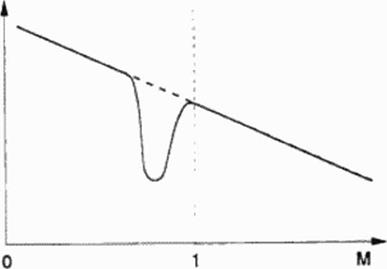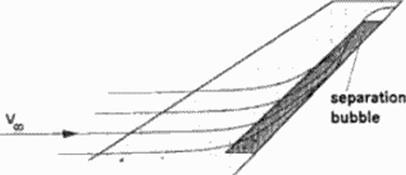Wind tunnel experiments are essential
• lo get insight into still unknown (low physics, like separation, turbulence, transition.
• to validate numerical calculations.
• to generate data for complicated configurations including interference effects.
• to check aerodynamic design cases and to generate data for improvement strategics.
• to establish aerodynamic data for pre-flight validation of new aircraft.
Wind tunnels have limitations as well. For SCT development the most important limitations for wind tunnel investigations are:
Reynold* number:
Reynolds number in wind tunnel testing usually is an order of magnitude lower than in free flight, for supersonic testing often up to two orders of magnitude For drag measurements the boundary layer is tripped; i. e. transition strips provoke transition from laminar to turbulent flow at defined positions. This allows for calibrated friction measurements, but the boundary layer i* thicker at lower Reynolds numbers. Therefore the interference effects, especially shock/boundary layer interference, in the wind tunnel remain different compared lo free flight. Technologies to transpose interference prediction from wind tunnel to free flight need to be developed
Transition control:
Transition strips must be as small a* possible. Thick or wide transition strips generate too much strip drag and thicken the boundary layer. On the other hand, if transition strips are too small, no transition or even reiaminarisation occurs which does not allow useful drag measurements. The control of transition in experiments, i. e. to identify the laminar and turbulent boundary layer regions on the whole aircraft model is always required Most common transition control methods – like the acenaphtenc technique – require w ind tunnel runs at constant flow conditions. This is impossible in wind tunnels of Mow-down type; and many supersonic wind tunnels are blow-down tunnels. Other transition control technologies are required here, possibly the techniques devoleped for cryogenic wind tunnels (like highly sensitive infrared measurements lean be adapted here.
Testing around Mach 1:
At near sonic speeds the flow around ihe model contains large supersonic flow domains. In the supersonic regions the wind tunnel model radiates disturbances to the wind tunnel wall and arc (at least partially) reflected by the wall back onto the model. In contrast to free flight conditions, this reflection strongly changes pressures and flow properties at the model.
At high subsonic speeds, the supersonic regions can reach the wall and so generate a choked supersonic nozzle flow over the aircraft instead of the open supersonic bubble over the free flying aircraft. This (partial) nozzle flow changes the whole flow field and docs not further resemble to free flight conditions.
Most transonic wind tunnels have slotted or perforated walls in order to minimize wall reflections. This minimisation, though, is only sufficient if the supersonic bubble does not reach the wall or the important reflections do not meet ihe model. This requires test flow conditions avoiding the vicinity of Mach I. New transonic wind tunnels use flexible (adaptive) walls, where the wall geometry is adapted during the lest to follow a free stream path line. This allows for better adaption of near sonic test conditions, but quality of adaption depends on the technical concept of the adaption mechanism: usually only a plane w all adaption is possible for two of the four walls surrounding the test chamber. Although two-dimensional adaption in the most important direction is much better than no adaption, three-dimensional adaption for three-dimensional models remains impossible.
Engine simulation:
Usually, engines in supersonic tests are modelled by simple through-flow nozzles, but it seems impossible to design spillage-free through-flow nozzles: nozzles arc choked, whereas an engine adds energy. Wind tunnel simulation is restricted therefore to cases including spillage. Additional nozzle base drag is created due to the choked flow. It can be corrected by pressure measurements on the nozzle, but these will correct only the individual nozzle base drag, not the additional interference wave drag
Laminar tests:
There is not yet any wind tunnel available for supersonic laminar flow tests between Mach 1.5 and 2.5. At the University of Stuttgart. Germany, a facility is refurbished which • hopefully – will be suited. See also the special chapter 18 on laminar flow for supersonic transports
Measuremeni techniques have been developed for exploiting wind tunnel experiments. Some of these techniques arc state of the art and provided by all wind tunnels: force measurement and pressure measurement via small holes in the model surface. The simpler optical methods like shadowgraphs. Schlicrcn or interferograms are best suited for 2D-measurcmcnts and available where suited. More refined techniques arc available and will be applied to supersonic testing, especially optical methods for flow field measurements:
Pressure sensitive paint (PSP):
Special paints arc developed which, when illuminated by a special light source, emit light depending on the amount of (^-molecules embedded in the paint surface. In air the amount of Os-molcculcs directly correlates to air density. This allows for a direct measurement of air density distribution on the model surface and. when temperature is known, indirectly for the measurement of pressure distribution, see. e g. (69). (70). (71). This technique is new and needs further improvements before it can be applied as a stand alone pressure measurement technique. Especially paint thickness or durability, painting, illumination technique and related automatic data processing need further research.
Liquid crystal coatings:
Surface coalings based on liquid cristal technology allow for various mapping techniques of relevant flow parameters on the model’s surface like shear stress and temperature. This allows simultaneous measurement on large parts of the model. Problems result from the relatively rough coating surface, die limited view angles and often the multiple sensitivities of the coatings which require careful separation of the measured effects. These problems presently still allow only for limited use of the technique in aerodynamic measurements.
Distribution measurements in the free flow field:
Several new techniques allow for measurements in a selected plane of the flow field. Most common is Particle Image Velocity (PIV). see e g. (72): The (low field of interest is seeded with microscopic particles, commonly droplets of about I pm diameter. In the plane of interest, those droplets are photographed twice within a short time interval. The movement of the droplets is identified to provide the droplet s speed which is equal to flow velocity except within a shock. New developments are aimed at larger measurement fields and measuring all three velocity components In the future. PIV measurements will be usable even for complicated interference flow measurements.
Several other flow field measurement techniques arc under development but either still in their infancy, restricted to high Mach numbers, suitable only for very specific cases or just of poor accuracy.
Laser-Doppler anemometry:
In the last years Lascr-Doppler Anemometry (LDA) was developed as a tool for accurate, pointwise, non intrusive flow field measurements |73|. The flow is seeded with droplets (like for PIV) which are observed within a small measurement volume. This volume is established by the crossing of two laser beams, where interference produces a sequence of light and shadow like a grid. Observed is the motion of the droplets through the inter-
fercnee grid, where the frequency of reflected light spots is correlated to the droplet’s speed. LDA allows for accurate measuring of mean and fluctuating values, even resolution of boundary layer flow, but it requires relatively long measurement lime.
Complementary to the experimental measurements correction methods for experimental errors or insufficient simulation are needed The most important corrections required are:
• accurate correction of wall interference.
• correction of Reynolds effects, especially for imerferencies.
• spillage and nozzle base drag correction, especially for flows without spillage.











 aerodynamic
aerodynamic